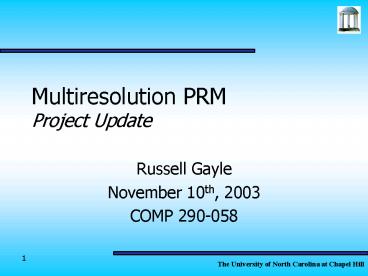Multiresolution PRM Project Update PowerPoint PPT Presentation
1 / 12
Title: Multiresolution PRM Project Update
1
Multiresolution PRMProject Update
- Russell Gayle
- November 10th, 2003
- COMP 290-058
2
Project Goals Review
- Create a multiresolution structure for PRM-based
planner - Some multiresolution structures like CLODs have
quicker distance checking - Since most of the time is spent computing link
queries, this could speed up PRMs - Apply to more complex environments
- For now, those with an arrangement of obstacles
that makes effective planning difficult - Maybe apply to scenes with high polygon count as
well
3
Revised Algorithm/Approach
- Preprocessing
- Compute CLODs for each obstacle and possibly the
robot - Multiresolution PRM
- Learning stage Build a roadmap based on coarse
representations of each obstacle. We can pick
these by bounding the maximum allowable error for
distance queries.
4
Algorithm/Approach contd
- Multiresolution PRM
- Query Stage (This is similar to the standard PRM
query stage) - Move the robot to the milestone nearest to the
start point (ensure this is obstacle free) - Perform a graph search to see if it can reach the
milestone nearest to the goal - If such a path exists, move the robot along the
path until we reach the milestone nearest to the
goal - Move the robot from that milestone to the goal
(ensure this is obstacle free) - If at any time, the path or milestone moves
within the error bound, perform a path refining
step
5
Refinements
- An idea
- Resample with some set number of milestones using
a finer resolution of the obstacle causing the
possible error - Connect these with the milestone before and after
the place in error and replan locally - If no path exists locally (in the event that the
coarser LOD had opened a passage too large, for
instance), we must replan the entire path
6
Some Problems
- Narrow passages
- Depending on how we refine our meshes, we may
reduce the effects of narrow passages - Refinements that are bounded by their parents
volume or more approximate ones - Similarly, we could increase the effects of even
close narrow passages - Refinements that are more conservative, it has a
volume greater than that of its finer levels
(However, any path found in this manner would
definitely work on finer levels) - Many refinement algorithms can do both depending
on the geometry
7
Main work done so far
- Got a well structured PRM planner to work
- Started experimenting with planning using meshes
at different resolutions - Currently using GAPS for mesh simplification, but
many other possibilities, like QSlim, exist - Learned about the MSL library structure to make
useful additions - MSL has a structure for working with different
types of problems and planners as well as a GL
renderer and GUI in place - Includes base classes of Models, Geometry,
Problem, Solver, and other graphics and gui
related classes
8
Some results
Based on model from MSL
9
Some results
10
Some results
11
Some results
12
What remains to be done
- Integrate CLOD code with existing planner
- Define a bounded error metric on distance queries
- Allow for quick query-stage path refinements
- Show current LOD for each obstacle
- Test this on many different types of environments

